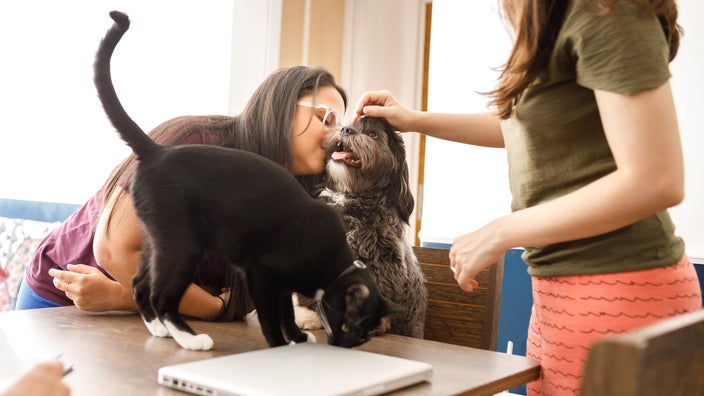
How Much Is Pet Insurance, and What Does It Cover?
Key takeaways:
There are two main types of pet insurance: comprehensive and accident-only. You can often add wellness, dental, and other benefits for an additional fee.
The cost of pet insurance will depend on your pet’s species, breed, and age, as well as your plan deductible, reimbursement percentage, and annual maximum benefit.
But the first step is figuring out if you actually need pet insurance. Then, if you decide to move forward, it’s important to research potential plans thoroughly so you get the best coverage and price for your needs.
Table of contents

Adopting a new dog or cat comes with many responsibilities, including ensuring that they have proper veterinary care. Pet insurance can be an effective way to make sure the newest member of your family has access to emergency healthcare, while protecting yourself financially.
Pet insurance is a financial product that helps cover the cost of veterinary care for your pet. It’s similar to health insurance for people in some ways. But most pet insurance plans won’t cover general checkups or preventative care unless you pay extra. However, for services that are covered, these plans can be used with any veterinarian — as opposed to having to choose a provider from a specific medical network.
While it can be helpful for many, pet insurance doesn’t make sense financially for everyone. To decide if it’s right for you, it’s helpful to know how much pet insurance costs and what it covers.
Search and compare options
What does pet insurance cover?
Most pet insurance plans cover your animal’s care in the case of emergency or serious illness. There are three major types of insurance available to pet owners, which are outlined below.
Comprehensive coverage
Comprehensive pet insurance — sometimes referred to as accident and illness coverage — has the widest range of benefits. These types of plans cover:
Accidents
Injuries
Chronic illness
Infections
Hereditary issues
Diagnostic care
Emergency care
On average, comprehensive coverage costs $640 for dogs and $387 for cats each year. These policies may exclude pets with pre-existing or genetic conditions. So check for those exclusions before making a purchase.
Accident-only coverage
Accident-only pet insurance coverage offers more limited benefits, and generally doesn’t cover care related to most illnesses. This type of policy is best suited for emergencies, such as:
Accidents
Injuries
Bites from animals or insects
Swallowed objects
Accidental poisoning
Read more like this
Explore these related articles, suggested for readers like you.
The yearly cost for accident-only coverage averages $200 for dogs and $122 for cats as of 2022.
Wellness coverage
Many insurance companies offer additional coverage options, such as well-visit benefits or dental coverage. These are typically sold as add-on options — also known as riders — to a pet insurance plan. Depending on the company, you may be able to add on wellness coverage for:
Annual checkups
Wellness visits
Vaccinations
Spaying or neutering
Some insurance plans also offer end-of-life care and beyond, covering things like urns for cremation. This varies from company to company. So verify whether or not these benefits are included before purchasing a plan if these are important to you.
Average cost of pet insurance
The cost of pet insurance varies widely depending on the company, the pet, coverage choices, and the state you live in.
The table below outlines the average cost of pet insurance as of 2022, according to the North American Pet Health Insurance Association (NAPHIA).
Cost of comprehensive coverage | Cost of accident-only coverage | |
Dogs | $53 per month ($640 per year) | $17 per month ($200 per year) |
Cats | $32 per month ($387per year) | $10 per month ($122 per year) |
Some pet insurance companies also charge a one-time enrollment fee, typically around $25, when you sign up for a plan. Some companies may also charge an installment fee, such as $3 per month, if you elect to pay monthly instead of in full.
Most pet insurance companies don’t provide detailed prices online. So to help you gain more insight into how much pet insurance costs, we used a test dog and cat subject to get sample quotes. While your costs may be very different in the end, these prices can help you get a sense of what your options are. Where possible, we tried to compare with the same deductible and coverage limits, though some plan details below vary slightly.
Estimated cost of dog insurance
We obtained a sample quote for dog insurance from a number of companies, using this dog as an example:
Boston terrier
3-year-old male
Lives in Cedar Rapids, Iowa
Insurance company | Cost for comprehensive coverage | Additional cost for wellness coverage |
$21 per month | $10-$17 per month | |
$21 per month | $16-$21 per month | |
$25 per month | $18-$27 per month | |
$26 per month | $10-$25 per month | |
$31 per month | $16-$27 per month | |
$31 per month | $39 per month | |
$36 per month | N/A | |
$36 per month | N/A | |
$39 per month | $12-$20 per month | |
$43 per month | $19-$52 per month | |
$43 per month | $19 per month | |
$44 per month | N/A | |
$48 per month | N/A | |
$54 per month | $10-$25 per month |
Estimated cost of cat insurance
To estimate the average cost of cat insurance, we used this cat as an example:
Mixed breed
4-year-old female
Lives in Corpus Christi, Texas
Insurance company | Cost for comprehensive coverage | Cost for wellness add-on coverage |
$12 per month | $11-$18 per month | |
$12 per month | $10-$25 per month | |
$13 per month | N/A | |
$14 per month | $16-$26 per month | |
$16 per month | N/A | |
$22 per month | $12-$22 per month | |
$22 per month | $12 per month | |
$24 per month | $10-$25 per month | |
$24 per month | $19-$52 per month | |
$26 per month | N/A | |
$27 per month | $8-$14 per month | |
$28 per month | N/A |
What are the factors that determine the cost of pet insurance?
The factors that can impact your pet insurance premiums generally fall into one of two categories, both of which are outlined below.
1. Factors related to your pet
Just like an auto insurance policy takes your age, driving history, and vehicle into consideration, a pet insurance policy also considers your unique situation when calculating how much you pay for insurance. That means considering characteristics of your pet, such as:
Species: While dogs and cats are the most commonly insured pets, there are plans that will cover other animals, like gerbils or bearded dragons. Exotic pets are much harder or impossible to insure.
Breed and size: Some dog and cat breeds are prone to certain health issues. People with these breeds may pay more for insurance or find themselves unable to get coverage.
Age: Your pet’s insurance premiums can (and likely will) rise as they age. This can eventually make pet insurance too expensive for many people. Most pet insurance companies won’t take your pet as a new customer after a certain age, usually 14 and older.
Multiple pets: Many pet insurance companies offer plan discounts if you enroll multiple pets for coverage. You typically save a percentage off each additional pet you insure.
2. Factors related to your policy
After an insurance company has considered your situation, you will have a chance to adjust certain aspects of your policy, which can bring down your premium. Choosing a lower reimbursement percentage or a higher deductible can help keep your costs lower, for example.
Items you can adjust to lower the cost of your policy include:
Deductible: Choosing a higher deductible — the amount you have to pay before your coverage kicks in — will lower your premium. A lower deductible will raise your monthly cost.
Annual maximum benefit: An annual maximum benefit caps the amount an insurance company pays for care in a given year. A plan with a $10,000 annual maximum benefit pays no more than $10,000 each year, even if your vet bills are higher. The more a plan can be required to pay in a year, the higher your premiums will be.
Reimbursement percentage: You may be able to choose to have insurance cover 60% to even 90% of your bills. If an insurance company pays a higher percentage of your vet bills, you can expect to pay more for your insurance rates.
Should I get pet insurance?
Determining whether or not you need pet insurance isn’t always an easy calculation. You may want to consider:
How your pet’s estimated veterinary expenses compare to the cost of insurance
Whether insurance will cover enough of your pet’s medical care to make it worth paying the monthly premium
Whether your pet insurance premiums will increase or stay the same over time
What lower-cost veterinary services are available in your area
That a single emergency or urgent care veterinary visit for your pet is often several hundred dollars or more
How you would feel about euthanizing a pet who needed expensive medical care you couldn’t afford
While pet insurance can be a helpful financial tool, many pet owners are shocked to find that their monthly premium amount increases each year. Because of these increases, most people only insure their pet for 3 years before the cost becomes unaffordable.
In an investigation from Consumers’ Checkbook, Trupanion and Healthy Paws were the only companies that didn’t increase premiums as pets aged, among the ones included in the investigation.
Another way to break down whether you need pet insurance or not is by making a pros and cons list. Below is a sample checklist.
Pros for purchasing pet insurance | Cons for purchasing pet insurance |
Plans can provide financial protection in the event of an unexpected accident or illness. | With a few exceptions, annual rising costs can make pet insurance unaffordable after just a few years. |
Pet insurance can give you peace of mind if you’re worried about emergency vet bills. | Exclusions and other plan limitations may lead to situations in which necessary medical care isn’t covered. |
Some insurance plans offer significant savings, especially for accident-prone animals or pets with multiple hereditary issues. | Most plans only cover a percentage of your vet bills, so you’ll still pay out-of-pocket costs, even with insurance. |
Most plans include an option to add wellness care, dental coverage, and other benefits for an additional charge. | Dealing with the insurance paperwork, claims, and payment process can be difficult. |
The bottom line
Pet insurance may be a helpful financial tool if you are concerned about the cost of veterinary care for your pet. How much you pay for pet insurance will depend on your pet and the type of coverage you choose. On average, it costs $200 to $640 a year to insure a dog and $122 to $387 a year for cat insurance.
Weigh your options carefully before buying a policy. Review and compare each policy’s cost, type of coverage, and limitations before making a purchase. You may also want to consider convenience factors, such as how claims are paid and ease of use, when deciding whether a plan — and which one — is right for you.
Why trust our experts?



References
American Veterinary Medical Association. (n.d.). Pet care.
Blyskal, J. (2022). Many pet insurance companies use misleading marketing. Consumers’ Checkbook.
Blyskal, J. (2022). The hustle: Many pet insurance premiums skyrocket as pets get old. Consumers’ Checkbook.
North American Pet Health Insurance Association. (n.d.). NAPHIA’s pet insurance buying guide.
North American Pet Health Insurance Association. (n.d.). Section #3: Average premiums.



























